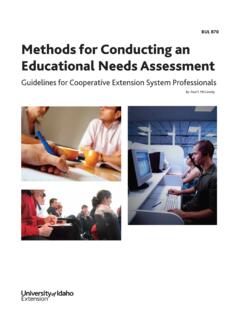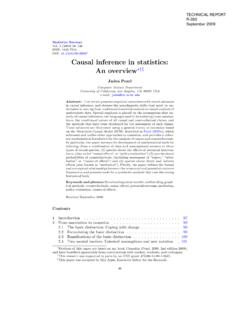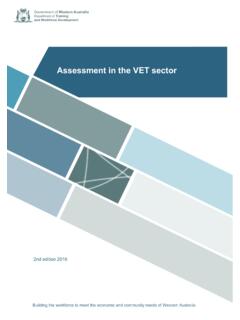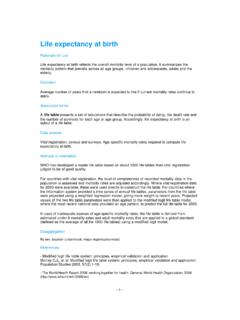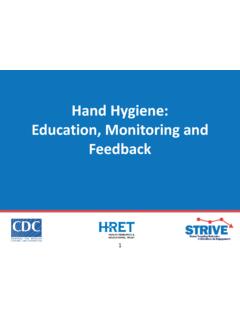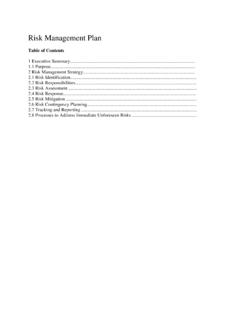Transcription of Assessment at a distance: Traditional vs. Alternative ...
1 The Turkish Online Journal of Educational Technology TOJET July 2003 ISSN: 1303-6521 volume 2 Issue 3 Article 2 13 Assessment at a distance: Traditional vs. Alternative Assessments Semire Dikli Florida State University Assessment performances are day-to-day activities that can also be authentic and engaging demonstrations of students abilities to grapple with the central challenges of a discipline in real life contexts (Kulieke, Bakker, Collins, Fennimore, Fine, Herman, Jones, Raack, & Tinzmann, 1990, ). Assessment is one of the crucial components of the instruction. People within the educational community, policymakers, educators, students, parents, administrators, have different ideas regarding the implementation of Assessment strategies (Dietel, Herman, and Knuth, 1991).
2 While some believe Traditional Assessment methods are more effective, others think that Alternative Assessment tools are superior. This article is written to inform people particularly in the field of distance education about Assessment practices at a distance. However, the content of Assessment is not a field specific and it can be applied to various instructional settings (Simonson, Smaldino, Albright, and Zvacek, 2000). Therefore, anyone who is directly or indirectly related to education distance or face-to-face- might find the information presented in this article useful. Assessment and testing Assessment and testing considerably differ from each other. While testing is formal and often standardized, Assessment is based on a collection of information about what students know and what they are able to do.
3 In other words, students are given the exact procedures for administering and scoring in testing. In Assessment , on the other hand, there are multiple ways and methods of collecting information at different times and contexts (Law and Eckes,1995, ). Dietel, Herman, and Knuth (1991) define Assessment as any method used to better understand the current knowledge that a student possesses (online document). According to Mitchell (1992, in Law and Eckes, 1995, p. 29) testing can be defined as single-occasion, unidimensional, timed exercise, usually in multiple choice or short-answer form. For a long time, student learning was measured only by testing in Traditional school settings. Currently, it is realized that there is not only one way of gathering information about student learning.
4 Furthermore, testing is seen as only one part of Assessment and a broader concept of Assessment is being widely used (Kulieke, Bakker, Collins, Fennimore, Fine, Herman, Jones, Raack, and Tinzman, 1990). Traditional Assessment tools: The most widely used Traditional Assessment tools are multiple-choice tests, true/false tests, short answers, and essays. True/false tests: True/false items require students to make a decision and find out which of two potential responses is true. Since they are easy to score, it is easy to administer true/false tests. However, guessing might increase the chance of success by 50%. Especially, when the test item is false, it is quite hard to find out whether the student really knows the correct response.
5 One possible solution is to ask student to provide with an explanation for the incorrect item, or rewrite the statement correctly. However, this affects the ease in scoring negatively (Simonson et al., 2000). Multiple-choice tests: Multiple-choice tests are commonly utilized by teachers, schools, and Assessment organizations for the following reasons (Bailey, 1998, p. 130): 1. They are fast, easy, and economical to score. In fact, they are machine scorable. 2. They can be scored objectively and thus may give the test appearance of being fairer and/or more reliable than subjectively scored tests. 3. They look like tests and may thus seem to be acceptable by convention. 4. They reduce the chances of learners guessing the correct items in comparison to true-false items.
6 Simonson and others discussed the disadvantages of multiple choice tests. They claimed that depending on the level of cognitive effort, they become harder and more time consuming to create. In other words, multiple choice items can be used effectively in testing the items that demand low level of cognitive effort such as recalling previously memorized knowledge, yet items that require students to use higher order thinking skills such as analyzing and synthesizing are more difficult to produce (2000). Similarly, Hughes (in Bailey, 1998) criticizes multiple-choice tests for the following aspects: The Turkish Online Journal of Educational Technology TOJET July 2003 ISSN: 1303-6521 volume 2 Issue 3 Article 2 14 1. the technique test only recognition knowledge, may have a considerable but unknown effect on the test scores, technique severely restricts what can be tested, 4 it is very difficult to write successful items, 5.
7 Backwash maybe harmful, 6. cheating may be facilitated ( ). Essays: Essays are effective Assessment tools since the questions are flexible and assess the higher order learning skills. However, they are not very practical due to the fact that it is very difficult and time consuming to score the essays. Moreover, subjectivity might be an issue in scoring. Creating a rubric might be helpful to grade the essays (Simonson et al., 2000). A rubric can be defined as a criteria-rating scale, which gives the teachers a tool that allows them to track student performance (Abrenica, online document). Instructors have an option to create, adapt, or adopt rubrics depending on their instructional needs. The templates provided on the web might be helpful for them to adjust the generic rubrics into their own instruction (Simonson et al.)
8 , 2000). Short-answer tests: In short-answer tests items are written either as a direct question requiring the learner fill in a word or phrase or as statements in which a space has been left blank for a brief written answer (Simonson et al., 2000, p. 270). Furthermore, the questions need to be precise. Otherwise, the items that are open to interpretations allow learners to fill in the blanks with any possible information (Simonson et al., 2000). Alternative Assessment tools: According to Simonson and others, there are three approaches in Alternative Assessment : Authentic Assessment , performance-based Assessment , and constructivist Assessment . Similarly, Reeves (2000) suggests three main strategies to integrate Alternative Assessment into online learning settings: 1.
9 Cognitive Assessment , 2. performance Assessment , 3. portfolio Assessment . Researchers and educators use the term performance-based, Alternative , and authentic Assessment interchangeably. As Wangsatorntanakhun (1997) states the term, performance-based Assessment , embraces both Alternative and authentic Assessment . Therefore, throughout this article, performance Assessment is used to refer to Alternative Assessment . There are two major concepts that describe performance Assessment : 1. Performance: A student s active generation of a response that is observable either directly or indirectly via a permanent product, 2. Authentic: The nature of the task and context in which the Assessment occurs is relevant and represents real world problems or issues (Elliott, 1995).
10 Authentic Assessment aims to relate the instruction to the real-world experience of the learners. The task needs to be meaningful in order to be authentic (Simonson et al.). Winking (1997) also points out the role of authenticity and states that Alternative assessments require higher order thinking skills so that students can solve real-life related problems. Finally, Bailey (1998) relates the power of the performance tests are not only to their authenticity, but also to their direct and highly contextualized nature. In order to increase the effectiveness of performance Assessment , instructors need to pay attention to the following points (Elliott, 1995): 1. Selecting Assessment tasks that are clearly aligned or connected to what has been taught. 2.












